High-low
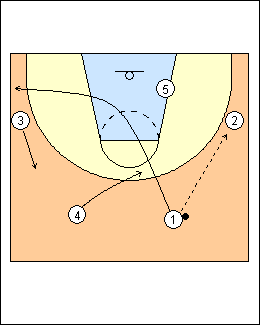 | 1 High-low is a continuity offence that exploits offensive match-ups on the perimeter and inside (with low-post 5). The weakside corner is the perimeter match-up spot. See Break 1, Break 2 and Break 3 for entries into high-low, also Carleton Ravens, and Double exit for an unconventional entry. Here 1 is the perimeter match-up (there can be more than one), so on a pass to 2 he basket cuts to the weakside corner, 3 moves high and 4 goes to the high post. If 3 is the perimeter match-up, then 1 would just move to the weakside wing and push 3 down to the corner. If 2 is denied, - 5 backscreens then re-screens to bring him out to the wing, - 2 cuts to the basket then uses a screen from 5 to get open on the wing, or - 1 dribble clears 2, exchanging places. With an open-post (5 starts weakside), 1 can pass to 2, basket cut looking for a return pass, cross-screen for 5, then empty weakside (Cross). If 2 is denied, 1 can dribble-at X2, 2 backcuts then cross-screens for 5 if there is no pass (Dribble-cross). |
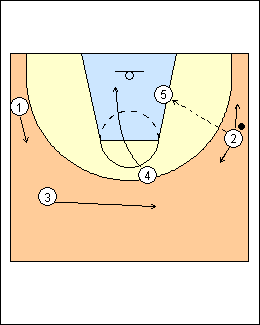 | 2 Wheel action - on a post-entry pass, 4 dives (always), 3 fills the top, 1 gets to 45 on the weakside, allowing a diagonal skip pass (4 would then step out to the short corner). Passer 2 relocates along the perimeter. Ian MacKinnon - dive high post 4, 2 should space away if his defender doubles down, going away from where he turns - if he turns to the baseline fill high, if he turns to the middle fill low. If 5 attacks the basket, space weakside 4 as in a perimeter attack. Jeff Van Gundy - on a low post catch, the other post goes under the backboard, leaving the middle open. Sebastien Roduit - a high post cuts to the weakside block, if 5 attacks middle, 4 fades to the corner if he is a shooter, or curls under the basket and the weakside wing drifts to the corner (can't have two in a row along the baseline). If 5 attacks baseline there should be a player in the weakside corner and weakside wing, 4 goes up the middle of the lane. Ian MacKinnon - if there are two ballside guards and a weakside low post you can screen on the perimeter or run an exchange, if there is no weakside low post you can run a Laker cut, running off the post for a hand-off or fake hand-off and forcing the post defender to hedge. The cutter goes opposite his defender, baseline or middle, if he has a post match-up he can stay in the post, if he clears out you can dive another post player. The weakside perimeter would be at 45, especially if you are running a Laker cut, the cutter can fill to the baseline. Bill Self (ballscreen offence) - if 5 kicks the ball out after a post-entry, he will chase the pass to ballscreen. |
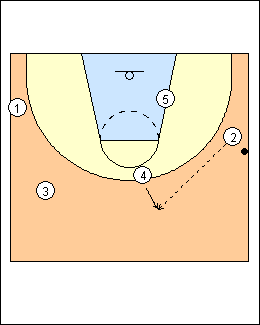 | 3 4 can step out top for a pass from 2. There is no help when 4 has the ball at the high post, he looks for a high-low pass to match-up 5 (X1 stays with 1) or a skip pass to 1 (X1 sags to help on 5). Rick Majerus - a high-post flash should be made to the nail, not to the ballside elbow, the high post and low post should never be on the same plane, a high-low pass is too difficult. A player with the ball in the high post must be able to see everyone. Bill Self high-low motion - 3 screens for 1 to get open (or 3 and 1 can interchange, 3 fake a screen for 1 and self replace, or 1 fadescreen for 3 then step to the ball), |
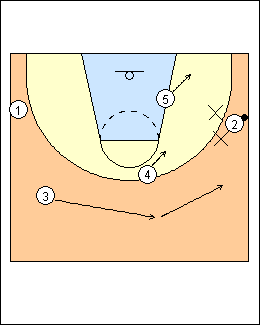 | 4 If 2 is in trouble on the wing, 5 goes out to the short corner, 3 gets high ballside or behind the ball as a third short passing option, and 1 gets in vision on the weakside. See Zone offence - Kermit Davis vs 1-3-1, and Memphis X. |
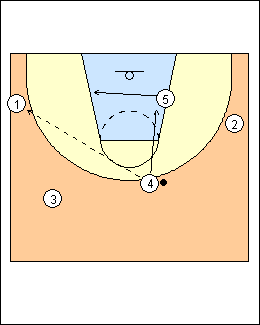 | 5 A skip pass from 4 to 1 is an attack situation, 4 dives weakside, 5 comes ballside and reads 1. Euro ballscreen offence - if 4 skip passes to 1 against a sagging defence, 3 cuts to the opposite corner. |
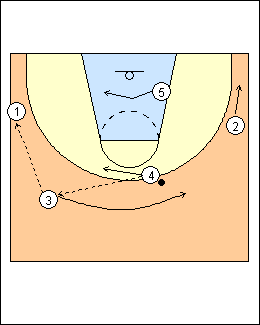 | 6 On a pass to 3, 5 ducks in and 4 stays, giving 3 a seam to attack. If the ball is swung to 1, get into high-low on that side, 3 spaces away. 3 and 1 look to shoot or attack a close-out. A skip pass from 3 to 2 is an attacking situation, 4 would dive weakside. Option - 4 can pass to 3 and follow to ballscreen (see Fist below). 3 backcuts if denied, 1 replaces. |
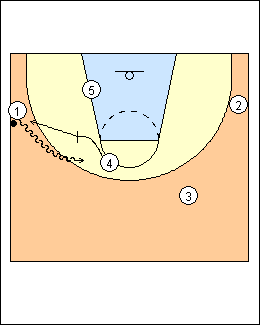 | 7 4 can ballscreen to help with ball reversal. a) Pick and pop 4 can look for 5 inside on a throw-back from 1. Bill Self ballscreen offence - Side - 4 pops for a pass and feeds 5. Unicaja Junior fast break - 4 picks and pops if the ball can't change sides because of good defence, 5 goes to the opposite low post to have more space for 4. Option - if 4 is denied, 1 drives at him for a backdoor cut, see Quick hitter - Cavs pistol series, Offence - New Jersey Nets. Patrick Hunt - if 4 is denied, 5 exit cuts to the short corner. Dennis Felton (Georgia) - the high post screens away any time he is denied (optionally on eye contact he stagger screens with 3 for 2 on the double side). |
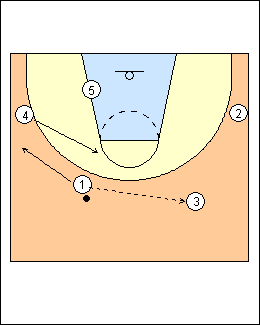 | 8 |
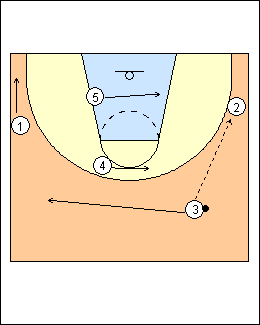 | 9 High-low when the swing is completed to 2. 3 pushes matchup 1 to the weakside corner (instead of cutting there himself). 4 pauses until 3 clears weakside. |
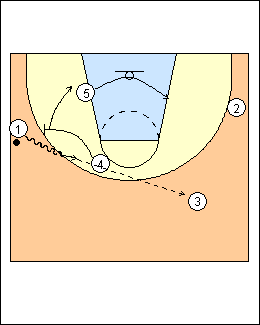 | 10 b) Pick and roll 5 goes low weakside (see Break 2). Get to high-low when 3 finishes the swing to 2 (3 clears, 4 comes high). Option - 5 comes high to the weakside elbow, then dives on a swing to 2, see Break 1. Also see Quick hitter - Portland ballscreen (5 screens for 2 to fill behind the ballscreen). |
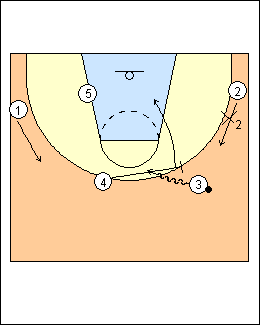 | 11 Fist If 3 can't finish a swing to 2, 4 can pick and roll, 2 fills behind the ballscreen (4 can't pick and pop with 2 in the corner). If 4 slips the screen, 5 comes high for a pass or keeps coming to ballscreen. Florida ballscreen offence - 4 slips a ballscreen, 5 comes out top for a pass, looks for 2 in the corner, 4 inside, or will pass to 1 and follow to ballscreen. Unicaja Junior fast break - 4 picks and pops, and needs space to play in isolation, so 2 has to move to the other side as the ballscreen is set. Also see Quick hitter - Cornell ballscreen (5 screens for 2). Brazil offence, FIBA Assist 42 - if 4 can't get the ball from 3 he makes a vertical screen for 5, exchanging positions. Jim Les (quick hitter) - 5 is at the high post and screens down for 4, who can shoot. Xavier - 4 pins down for 5, look for a high-low pass to 4. Seth Greenberg (slice offence) - if 4 is denied at the top he takes one step out then backcuts, 1 fills, 2 runs the baseline. |
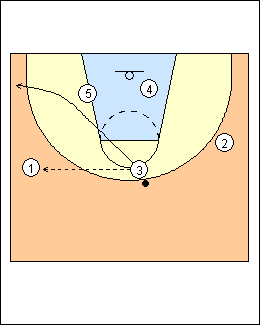 | 12 a) 3 passes to 1 and cuts to the ballside corner. |
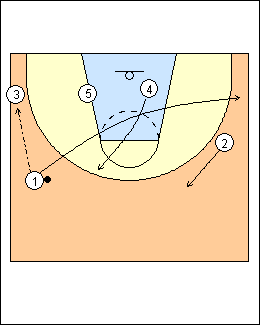 | 13 Get into high-low on a return pass to 3. Triangle offence option - 4 comes out top on the pass to 3, 5 backscreens for 1 then picks and rolls, see Quick hitters - Canes (Xavier option - as 5 ballscreens, 4 screens away for 2 from the top). Xavier backdoor flash - when 1 has the ball, 4 comes high then backcuts, 1 looks to drive middle. |
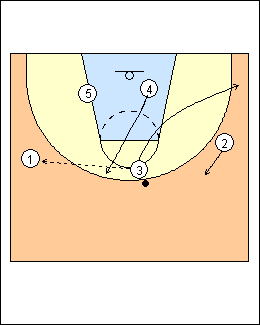 | 14 b) 3 could pass to 1 and cut to the opposite corner, 4 comes high. Bill Self high-low motion - 4 would catch with an inside (right) pivot but make a cheat step outside with his left foot for balance, then forward pivot to square up. Ian MacKinnon - 4 would catch with an outside (reverse) pivot to create space. |
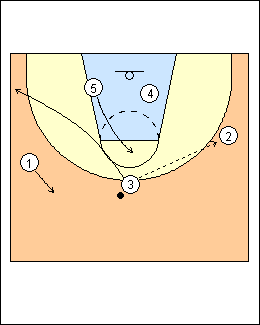 | 15 c) 3 clears opposite on a throw-back to 2, who can shoot, post feed 4, hit 5 flashing for a high-low if 4 is fronted, or wait for 5 to step out and pick and roll (to get back inside). Option - to keep 5 low, 4 posts for a second then cross-screens and comes high. Bill Self - 4 can set a flat (butt) ballscreen for 2 - if 2 passes to 5 and he can't make a high-low pass, reverse the ball to 1 and ballscreen. |
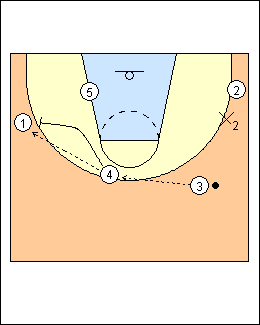 | 16 Here 3 passes to 4 when 2 is denied, 4 looks for a high-low pass to 5 then passes to 1 and follows to ballscreen. See Tactics - Nail pick and roll for other options if 3 passes to 4 at the high post (e.g. 5 ballscreens for 4). John Brady (LSU fast break) - high post 4 can follow his pass to ballscreen, or stagger screen with 3 for 2. Jim Les (Bradley fast break) - 3 and 2 can interchange when 3 passes, or 2 can go baseline. |
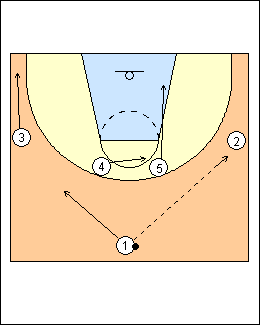 | 17 Against zone defence, a 1-4 entry set can be used. |
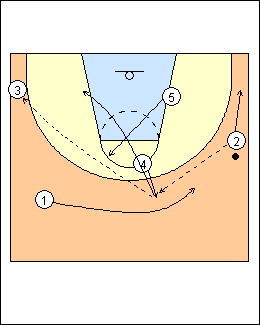 | 18 4 and 5 x-cut when the ball is skipped or reversed to 3, the high post goes first (4 and 5 can be interchangeable in the zone attack). See Zone offences - High-low, Hubie Brown 1-4, Memphis X, Geno Auriemma. coachesclipboard.ca Getting the ball into the middle of the zone is a fundamental principle, this can be done by dribble penetration, flashing into the middle, or posting at the elbows. Flash from behind the zone with your back to a sideline, hands up, stop or pause in a gap between the top and bottom rows of the defence. Against zone defence, playing at the elbow (with your back to the far sideline) is much more effective than the middle of the foul line for several reasons, - a shorter pass from the wing - on a catch, better vision to the low post and wings - a weakside defender most come over further to help, making for easier ball reversal and more difficult point coverage - on ball reversal, more space for penetration from the top - a better cutting angle if the posts will x-cut on reversal - (otherwise) post near the elbow against a guard defender recovering from the ball after a reversal pass from the wing (seal him outside). Perimeter players must get every third pass into the high post, see the middle of the zone, be patient (wait for cutters), and use pass fakes to create passing lanes (e.g., a pass fake from the wing to the top will often influence the top defenders higher). Sheri Coate - the weakside post attacks the area where the (on-ball) defender comes from (high post or short corner), the ballhandler must know where his defender came from. |
This page was made with Basketball playbook from Jes-Soft